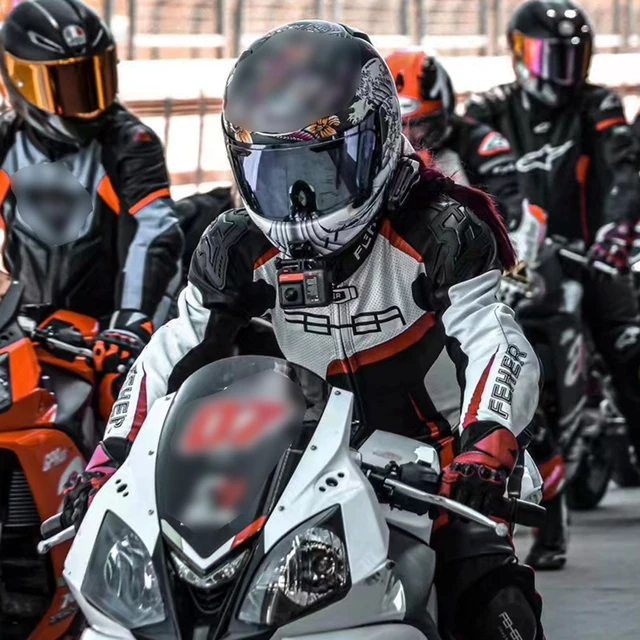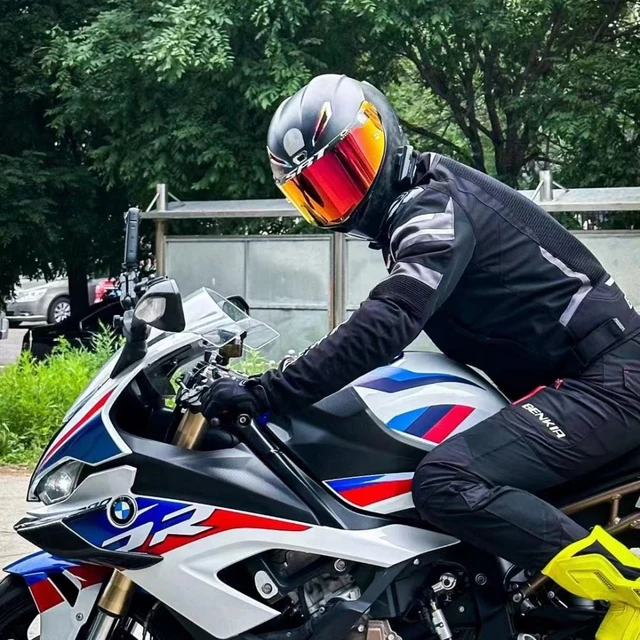Introduction:
Motorcycle leather suits are essential for serious riders, providing an unmatched level of protection and performance. This comprehensive guide explores the importance of a motorcycle leather suit, its features, materials, styles, fit, maintenance, and more, offering a deep understanding to ensure that you make the best choice for your riding needs.

Why Choose a Motorcycle Leather Suit?
Key Benefits of a Motorcycle Leather Suit
Motorcycle leather suits offer numerous benefits that extend beyond their stylish appearance, playing a crucial role in rider safety and comfort.
Superior Protection: Leather suits provide superior abrasion resistance compared to textile materials. In the event of a fall, leather’s durability minimizes the risk of skin injuries, making it the preferred choice for many riders.
Integrated Armor: Most leather suits come with integrated protective armor at critical points such as the shoulders, elbows, knees, and back. This armor absorbs shocks and reduces the impact from falls, protecting the rider’s vital areas.
Aerodynamics: High-quality leather suits are designed with aerodynamics in mind, reducing drag and allowing for smoother airflow. This feature enhances the rider’s speed and stability, particularly important for track racers.
Comfort and Fit: Leather suits are designed to fit snugly, allowing for optimal movement while riding. They often feature stretch panels and ergonomic designs that enhance flexibility, ensuring comfort during long rides.
Climate Adaptability: Many modern leather suits include ventilation systems and removable liners, making them adaptable to various weather conditions. These features help keep the rider cool in summer and warm during cooler months.
Essential Features of a Motorcycle Leather Suit
Understanding the key features of a motorcycle leather suit can assist you in making an informed choice tailored to your specific needs.
Quality Leather: Look for suits made from full-grain or top-grain leather. These types provide the best blend of durability, protection, and comfort. The leather should be thick enough to offer protection but still flexible.
CE-Certified Armor: A quality leather suit should include CE-certified armor in critical areas. This certification ensures that the armor meets European safety standards, offering reliable protection.
Ventilation: Ventilation zippers or perforated leather panels help maintain airflow, reducing overheating. Effective ventilation is crucial for comfort, especially during hot weather or intense riding sessions.
Stretch Panels: Stretch panels made from materials like Kevlar or spandex offer greater flexibility and mobility. These panels are typically located in high-movement areas such as the knees, elbows, and back.
Removable Liners: Removable thermal liners and moisture-wicking mesh liners increase the suit’s versatility, allowing you to adapt to different weather conditions.
Sealed Seams: Sealed seams enhance the suit’s durability and resistance to wear. They prevent water and wind from penetrating the suit, maintaining comfort and protection.

Choosing the Right Style of Leather Suit
Selecting the right style of leather suit depends on your riding needs and preferences. Different styles cater to various types of riding, offering unique benefits.
One-Piece Suits: One-piece suits are preferred by professional racers and track riders. They provide the highest level of protection and aerodynamics, with fewer seams and potential weak points. The snug fit ensures maximum movement efficiency and safety.
Two-Piece Suits: Two-piece suits offer versatility, as they can be worn separately or zipped together. They are ideal for riders who may need to remove the jacket when off the bike, providing convenience without compromising protection.
Street Style Suits: Street style suits combine protective features with everyday practicality. They balance performance and comfort, suitable for both track days and city commuting. These suits often feature more casual aesthetics, making them versatile for various settings.
Adventure/Touring Suits: Adventure or touring leather suits are designed for long-distance riders. They emphasize comfort, utility, and weather protection. These suits often include multiple pockets, adjustable features, and enhanced ventilation for extended rides.
Retro/Vintage Suits: Retro or vintage-style leather suits offer a classic aesthetic combined with modern protection. These suits appeal to riders who appreciate timeless design and want a stylish yet functional outfit.
Getting the Right Fit for Your Leather Suit
A proper fit is crucial for both safety and comfort when choosing a motorcycle leather suit. Here’s how to ensure the right fit.
Accurate Measurements: Take precise measurements of your chest, waist, hips, inseam, and arm length. Use these measurements to compare with the sizing chart provided by the manufacturer. It’s essential to consider your riding posture when measuring.
Snug Fit: Leather suits should fit snugly without being overly tight. A close fit ensures the armor stays in place during an impact, providing optimal protection. The suit will break in and become more comfortable over time.
Range of Motion: Ensure the suit allows a full range of motion. Move around, simulate riding positions, and ensure you can comfortably reach the handlebars and controls without restriction.
Layering Considerations: Consider the type of layers you will wear under the suit. If you ride in varying weather conditions, ensure there’s room for thermal layers without compromising comfort or mobility.
Adjustment Features: Look for suits with adjustable features such as waist straps, wrist and ankle closures, and stretch panels. These adjustments help customize the fit to your body and riding style.

Materials Used in Motorcycle Leather Suits
The materials used in leather suits significantly impact their performance, durability, and comfort. Here’s an overview of common materials and their benefits.
Full-Grain Leather: Full-grain leather is the highest quality, offering exceptional durability and protection. It retains the natural grain, providing a tough exterior that resists abrasion and wear. This leather will develop a unique patina over time.
Top-Grain Leather: Top-grain leather is slightly more affordable than full-grain but still offers excellent strength and protection. It has been sanded to remove imperfections, resulting in a smooth and uniform finish.
Perforated Leather: Perforated leather includes small holes that allow for better airflow, reducing heat build-up. This material is ideal for warm weather riding, providing ventilation while maintaining protection.
Superfabric: Superfabric is an advanced material often used in high-wear areas of leather suits. It combines textile with tiny, hard guard plates, providing enhanced abrasion resistance without significantly adding weight.
Kevlar: Kevlar is a strong, heat-resistant material used in stretch panels and reinforced areas. It offers flexibility and additional protection in critical zones like knees and elbows.
Mesh Liners: Moisture-wicking mesh liners help keep the rider cool and dry. These liners are breathable, promoting airflow and comfort during long rides.
Maintenance of Leather Motorcycle Suits
Proper maintenance ensures that your leather motorcycle suit remains in top condition, providing lasting protection and comfort.
Regular Cleaning: Wipe down the suit with a damp cloth to remove dirt and bugs after each ride. Use a mild leather cleaner for deeper cleaning, following the manufacturer’s instructions. Avoid using harsh chemicals that can damage the leather.
Conditioning: Apply a high-quality leather conditioner every few months to keep the leather supple and prevent drying out. Conditioning helps maintain the flexibility and durability of the leather.
Waterproofing: If your suit isn’t already waterproof, apply a leather water repellent spray. This treatment helps protect the leather from rain and moisture, preserving its integrity.
Storage: Store the suit in a cool, dry place away from direct sunlight and heat sources. Use a padded hanger to maintain the suit’s shape, and cover it with a breathable garment bag to prevent dust accumulation.
Repair: Address any damages promptly. Small tears or loose stitching can be repaired with a leather repair kit, while more significant damage may require professional attention. Keeping the suit in good repair ensures its protective qualities remain intact.
Ventilation: After a ride, allow the suit to air out thoroughly. Open all zippers and hang it in a well-ventilated area to prevent odors and mold growth.

Customization and Personalization Options
Many riders prefer customizing their leather motorcycle suits to reflect their personal style and preferences. Here’s how you can personalize your suit.
Custom Fit: Brands like Alpinestars and Dainese offer custom fit options, allowing you to have a suit tailored to your exact measurements. This ensures a perfect fit and enhanced comfort.
Colors and Graphics: Choose custom colors and graphics to make your suit unique. Some manufacturers offer bespoke services where you can select specific colors, prints, and finishes.
Patches and Logos: Adding patches and logos is a popular way to personalize your suit. Whether it’s team logos, favorite brands, or personal symbols, these additions make your suit one-of-a-kind.
Name and Number: Many professional and amateur racers add their name and number to their suits. This personalization helps in identification and adds a professional touch to the gear.
Embroidery: Embroidery offers a classy and durable way to add custom designs to your suit. Consider adding your initials, name, or unique designs through high-quality embroidery.

Conclusion
A motorcycle leather suit is a vital piece of gear that combines style, protection, and performance. Understanding the key benefits, essential features, materials, and fitting guidelines ensures you make an informed choice tailored to your riding needs. Proper maintenance, exploring popular brands, considering customization options, and being mindful of environmental and ethical factors all contribute to the longevity and effectiveness of your leather suit. This comprehensive guide equips you with the knowledge to select and care for a high-quality motorcycle leather suit, providing the ultimate riding experience.

